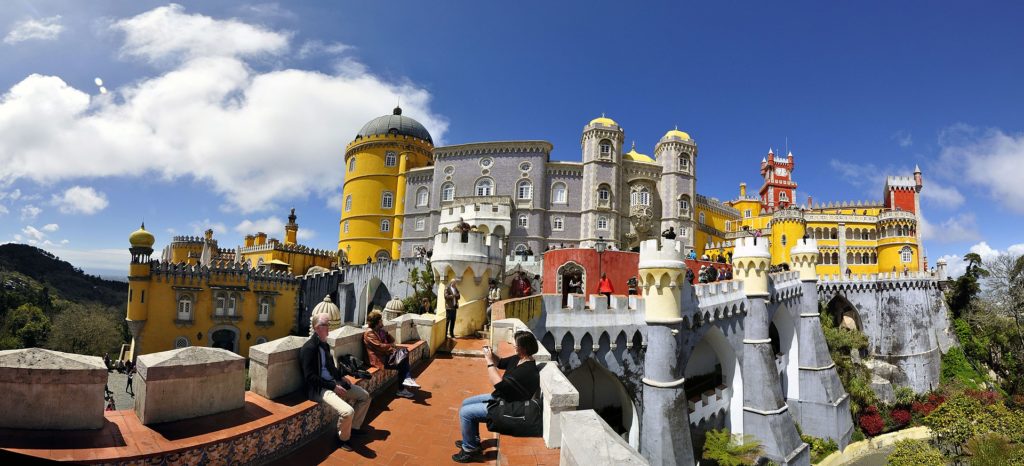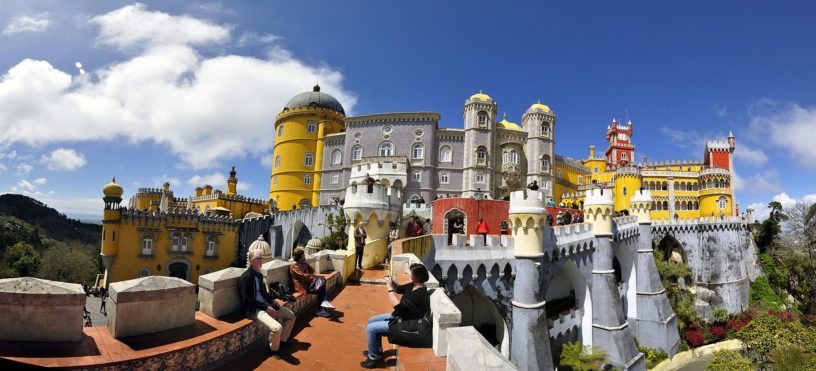
By Diego Delso – Wikimedia
Top 10 Facts about the Park and National Palace of Pena in Portugal
A visit to Portugal is not complete without a visit to this fairy-tale-like park and palace. The Palace stands out and acts as a landmark to many that travel to Sintra.
Its bright yellow colour can be spotted from as far as Lisbon on a clear day. The Palace is located in the Sintra Mountains in the town with the same name.
This national monument is a UNESCO World Heritage Site and one of the Seven Wonders of Portugal. The architecture of this Palace is Romanticism popular in the 19th century.
The Palace is also used for state functions by the President of the Portuguese Republic and other government officials.
A Park is surrounding the Palace known as Pena Park. It is about 200 hectares. The park is home to different species of plants from different parts of the world.
A visit to this Palace offers the most stunning panoramic views of the ocean beyond.
Here are the top 10 facts about the Park and National Palace of Pena in Portugal.
1. The National Palace of Pena is a true definition of romanticist castle

By GlynLowe – Wikimedia
A look at this Palace and you would not be wrong to think it came out of a fairy-tale story. It was built by a Portuguese king who lived in it with his family.
Having once been a monastery, the architecture of the Palace is quite significant. It is a UNESCO World Heritage Site.
The architecture of this Palace is considered to be dramatic and an expression of the 19th-century romanticism.
It expresses neo-romanticism, which was very popular in the 19th century.
2. Its location is amazing
Other than its apparent architectural sophistication, the location of the palace makes it all the more amazing.
The Palace stands on top of a hill on the Portuguese Riviera. It is located in São Pedro de Penaferrim, part of the municipality of Sintra.
Construction of the Palace was easy since the rocks used were readily available on the hill. The Palace can be seen from any part of Lisbon on a clear day.
3. The Palace was once a Chapel

By G. Vivian – Wikimedia
Before the Palace was built, there was a small chapel at this ground. King John II together with his wife Queen Leonor was part of the pilgrims that visited the chapel.
The chapel, which was built in the middle ages, was dedicated to Our Lady of Pena.
Another King, Manuel I, ordered the construction of a monastery which was donated to the Order of Saint Jerome. It was a quiet place where 18 monks lived.
The monastery was built in 1511 but the monks moved in in 1834.
4. It was abandoned after a devastating earthquake

By GlynLowe – Wikimedia
On November 1755, a devastating earthquake shook the city of Lisbon. The monastery suffered several damages and its occupants abandoned it. The chapel was not entirely ruined by the earthquake.
It remained abandoned for almost a century. The state possessed the ruins in 1834 after the suppression of the religious orders in Portugal.
A private owner bought the land from the government in 1838. A monument was built to commemorate the rebuilding of the city. The monument is called the Rua Augusta Arch.
5. Construction of the Palace was done after an apparition of Virgin Mary
The history of the chapel that was the first building here, dates back to the middle ages. It is believed that the chapel was constructed after an apparition of the Virgin Mary was seen.
6. King Ferdinand II renovated the ruined Chapel

By Kamran Saraf – Wikimedia
For many decades the ruins remained untouched. In 1838, King Ferdinand acquired the monastery and the surrounding land.
He transformed the monastery into a palace that he used as his family residence during the summer.
A German mining engineer, Wilhelm Ludwig von Eschwege, was commissioned to design the Romantic style.
Although he was an amateur architect, he was well travelled and had visited several castles along the Rhine river.
The construction took place between 1842 and 1854. In 1847, the King and his wife suggested a few alterations on the design of the Palace.
They suggested the addition of vault arches, Medieval and Islamic elements. The King also designed an ornate window for the main façade.
7. The Pena Park around the Castle is beautiful
Pena Park surrounding the palace features ponds, fountains, statues, lovely walking trails and several exotic plants from former Portuguese colonies.
The park spreads on the land of about 85 hectares. It occupies most of Serra de Sintra.
A walk through the garden, one can spot Camellias, tree ferns, conifers, and other natural vegetation.
The arboretum contains impressive individual specimens of Cryptomeria japonica, Sequoia sempervirens, Thuya plicata and various species of Abies.
This park has been part of the Portuguese National forest service since 1910.
8. The Park is made up of several gardens

By Husond – Wikimedia
The Park of Pena is made up of several landscaped gardens stretching over 85 hectares. Native and exotic plant species from all over the world can be found in the gardens.
This park is considered as one of the beautiful sceneries in both Portugal and Europe.
There is an extensive system of water features such as waterfalls, ponds, lakes and fountains. There are also small decorative buildings scattered around the park.
All these details in the park share the romantic atmosphere of this historic park.
The king ordered trees from different countries to be planted in the garden. The diverse tree species include North American sequoia, Lawson’s cypress, magnolia and Western redcedar, Chinese ginkgo, Japanese Cryptomeria, and a wide variety of ferns and tree ferns from Australia and New Zealand.
9. It is the most visited Castle in Portugal

By Ajay Suresh – Wikimedia
This palace is one of the most visited historical sites in Lisbon. The bright and beautiful colours of the Palace get repainted every few years. Red and yellow colours on the façade make the Palace stand out.
This Palace was listed as part of the UNESCO World Heritage Site in 1995.
10. The Castle displays different architectural designs

By Peter K Burian – Wikimedia
Built by German architect Baron Wilhelm Ludwig von Schewge, the palace exhibits a blend of Neo-Gothic, Neo-Islamic, Neo-Renaissance, and Neo-Manueline architectural styles.
The interiors of the palace have ornate decorations with tiles displaying amazing stucco sand Trompe-loeil painted walls. The style is borrowed from the late Victorian and Edwardian era.
Planning a trip to Paris ? Get ready !
These are Amazon’s best-selling travel products that you may need for coming to Paris.
Bookstore
- The best travel book : Rick Steves – Paris 2023 – Learn more here
- Fodor’s Paris 2024 – Learn more here
Travel Gear
- Venture Pal Lightweight Backpack – Learn more here
- Samsonite Winfield 2 28″ Luggage – Learn more here
- Swig Savvy’s Stainless Steel Insulated Water Bottle – Learn more here
Check Amazon’s best-seller list for the most popular travel accessories. We sometimes read this list just to find out what new travel products people are buying.










